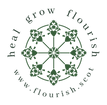#healgrowflourish
thank you for your interest in flourish.
services are no longer available.
You can now find flourish's new incarnation at www.volva.co.uk
Whilst the art of Reflexology dates back to Ancient Egypt, India and China, this therapy was not introduced to the West until Dr William Fitzgerald developed 'Zone therapy'. He believed that reflex areas on the feet and hands were linked to other areas and organs of the body within the same zone.
In the 1930's, Eunice Ingham further developed this zone theory into what is known as modern Reflexology. Her opinion was that congestion or tension in any part of the foot is mirrored in the corresponding part of the body.
Reflexology is based on the principle that reflex points on the soles, tops, and sides of the feet correspond to different areas of the body. In this way, the feet can be seen as a ‘map’ of the body.
By applying specialised massage techniques to specific reflex points - using the thumbs, fingers and knuckles – the aim of a Reflexology treatment is to help restore balance to the body naturally by encouraging the body to self-regulate, improving general well-being.
I also work reflex points on the hands in a specific Hand Reflexology session for clients who have sustained an injury and are unable to receive Foot Reflexology. although it is the feet that are most commonly treated in Reflexology.
What to expect during a Reflexology treatment
We begin with a full consultation, asking various questions about your health and lifestyle, to ensure Reflexology is right for you. For the treatment itself you will remain fully clothed, simply removing your shoes and socks. You’ll be invited to relax on a reclining chair or treatment couch, or to put your feet up on a footstool. In preparation, your feet will be gently cleansed before applying a fine powder, cream or balm to help provide a free-flowing treatment - in many of my treatments I use my own handcrafted Ayurvedic Foot Balm. A gentle introductory massage and stretching of your feet and ankles allows your feet to relax before applying Reflexology.
As the treatment progresses, a variety of different Reflexology techniques will be used to ‘work’ the reflex points on each foot, including a caterpillar-like movement called ‘thumb walking’. The areas treated and pressure applied will be adapted to suit your individual needs which we will have discussed during the consultation. Treatment generally lasts for an hour although I recommend 90 minute sessions for specific conditions as these are more appropriate in helping to manage the symptoms.
Benefits of Reflexology
Reflexology can help to relieve anxiety and tension, encourage relaxation, improve mood and aid sleep and often it is used to help manage more specific health challenges. Reflexology is often used alongside conventional care in hospices, hospitals and other healthcare settings to help support patients with a variety of conditions. I recommend Treatment Plans, a course of dedicated sessions, for managing the symptoms of specific conditions.
Reflexology can help manage the symptoms of a wide range of conditions.
-
Women’s Health including Fertility, Endometriosis, PCOS, PMS and Menopausal symptoms
-
Preparation for pregnancy and labour; Post natal care
-
Stress, Anxiety, Panic attacks
-
Depression
-
Migraines, Tension headaches
-
Epilepsy
-
Low or high blood pressure
-
Diabetes
-
Fibromyalgia and Chronic Fatigue Syndrome/ME
-
Digestive and elimination problems including constipation, IBS, food allergies, flatulence
-
Chronic pain, including muscle tension, back, shoulder and neck pain; leg, knee and foot pain
-
Circulatory problems
-
Arthritis
-
Sciatica
-
Plantar Fasciitis
-
Sleeping disorders
-
Repetitive strain injuries
-
Skin disorders including psoriasis, eczema and acne rosacea
-
Breathing disorders including asthma, chest infections, cough infections, coughs and colds; ear, nose and throat problems
-
Life limiting illness including Cancer, Multiple Sclerosis (MS), Parkinson’s Disease, Alzheimer’s Disease, Motor Neuron Disease (MND)
Footmap Image Credit: The Reflexology Handbook by Laura Norman
.png)
